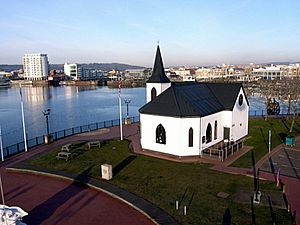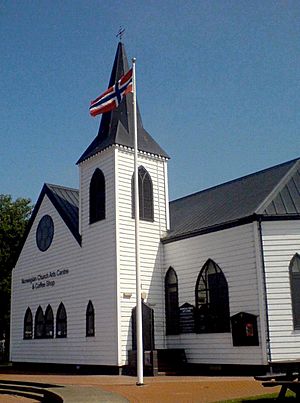Norwegian Church, Cardiff facts for kids
Quick facts for kids Norwegian Church Arts Centre |
|
|---|---|
 |
|
| Location | Cardiff Bay |
| Built | 1868 |
| Original use | Lutheran Church |
| Current use | Museum; Arts Centre; Cafe |
| Visitors | 180,000 (in 2018/19) |
| Owner | Norwegian Church Preservation Trust |
| Website | http://www.norwegianchurchcardiff.com |
The Norwegian Church Arts Centre (also known as Welsh: Canolfan Gelfyddydau'r Eglwys Norwyaidd in Welsh) is a special place in Cardiff Bay, Wales. It was once a Lutheran Church, opened in 1868. For over a hundred years, it was a welcoming spot for Norwegian sailors and the Norwegian community in Cardiff. It offered them a place to worship, feel at home, and connect with their families.
Contents
History of the Church
In the 1800s, Cardiff was one of Britain's busiest ports, like London and Liverpool. At that time, Norway had the third-largest merchant fleet in the world. Cardiff became a very important hub for their ships.
The Sjømannskirken, which is the Norwegian Church Abroad organization, decided to build a church in Cardiff. In 1868, a church was built in Cardiff Bay. It was located between the East and West Docks. The land for the church was given by the John Crichton-Stuart, 3rd Marquess of Bute. This church was meant to serve the religious needs of Norwegian sailors and people from Norway living in Cardiff.
The church opened in December 1868. It was covered in iron sheets because the harbourmaster wanted it to be easy to move if needed. This design also made it simple to add new parts over time:
- In 1883, the reading room was made bigger.
- In 1885, a gallery and a bell-tower were added.
- In 1894, the reading room was enlarged again and covered in wood.
At first, it was called the Norwegian Iron Church. Later, it became known as the Little White Church. It was a comforting place for sailors. It was open to all sailors, offering food and shelter. Between 1867 and 1915, the number of sailors visiting the church grew a lot, from 7,572 to 73,580 each year.
The Original Community
When the church was most active, it was a busy place. Many people from Nordic countries settled in Cardiff and made it their home. Norwegian sailors also used the church as a place to rest during their journeys. During World War II, the church became a "home away from home" for sailors. They could not return to Norway because of the war. The church hosted many important family events, like weddings and christenings. It also offered educational activities, such as cooking classes.
Why the Church Closed
Even before World War I, coal exports from Cardiff started to decrease. After World War II, shipping trade moved away from Cardiff. In 1959, the mission's work at the church stopped. In the early 1960s, the Norwegian Seamen's Mission no longer supported the church. The last priest, Per Konrad Hansen, left. The remaining church members and other Lutheran groups helped keep it open for the Norwegian community living there. However, the church finally closed in 1974.
Saving the Church
In the late 1980s, new buildings and roads were planned for Cardiff Bay. The church, which was now empty and damaged, was in danger of being completely destroyed.
To save the building, the community created the Norwegian Church Preservation Trust. They worked with the Norwegian Support Committee in Bergen, Norway. Together, they raised £250,000. This money allowed the church to be carefully taken apart in 1987. Its pieces were saved and stored. The original parts that remained, like the pulpit, a side-window, the chandelier, and a model ship, were also rescued. All these items were later returned to the church.
The original site of the church is now where the Wales Millennium Centre stands. Land for the church's new location was given by Associated British Ports. In 1992, the church was rebuilt on its current site. In April 1992, Princess Märtha Louise of Norway officially reopened the church.
Roald Dahl's Connection
The famous writer Roald Dahl was born in Cardiff. His parents were Norwegian. He and his sisters were baptised in this church, and his family attended services there. Throughout his life, Dahl stayed connected to the church. In the 1970s, when the church started to fall apart, Dahl was a leader in the effort to raise money to save it. Because of his help, Dahl was chosen as the first president of The Norwegian Church Preservation Trust when it was formed in 1987.
One room in the church is called 'The Dahl Gallery'. It honors Roald Dahl and what he did for the church. In this room, you can find:
- The silver bowl used to baptise Dahl and his siblings.
- A shield given to the church's pastor. This was a gift because during World War II, the church helped sailors who could not go home.
- An anchor and oars shaped like a cross. The oars are thought to be from a Norwegian sailing ship. The anchor is a gift to celebrate the church's history with the sea.
Besides this special room, Dahl is also celebrated every September. This is the month he was born in 1916. In 2016, Cardiff Bay celebrated 100 years since Dahl's birth with a project started by The Norwegian Church.
The Church Today
Today, the building is an arts centre. It is known as the Norwegian Church Arts Centre. The centre has a café and an art gallery. In May 2011, the church was updated. This work cost GB£500,000 (equivalent to £500,000 in 2021). It included a new outdoor terrace and a lift that meets modern accessibility standards. The Grieg room at the centre hosts many local art and cultural events.
See also
- Norwegian Church, Swansea
- Norwegian Fishermans' Church, Liverpool
- Religion in Wales
- Scandinavian churches in London
- Cardiff Docks


